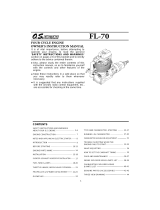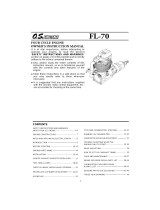
D If, at this time, the engine is slow to pick up and pro-
duces an excess of exhaust smoke, the mixture is too
rich. Correct this condition by turning the Mixture
Control Screw clockwise. If the mixture is extremely
rich, engine rpm will become unstable: opening the
throttle will produce a great deal of smoke and rpm may
drop suddenly or the engine may stop. This condition
may also be initiated by an excessively prolonged warm-
ing-up period.
E If, on the other hand, the mixture is too lean, this will
be indicated by a marked lack of exhaust smoke and a
tendency for the engine to cut out when the throttle is
opened. In this case, turn the Mixture Control Screw
counter-clockwise to enrich the mixture.
F Turn the Mixture Control Screw 30 degrees at a time.
G Having provisionally set the idle mixture, the next step is
to adjust the mixture for hovering flight.
H Hover the model and actuate the throttle to observe res-
ponse over the medium speed range. If the engine smokes
excessively and throttle response is poor, the mixture is
too rich; in which case, land the model and turn the
Needle Valve clockwise. Do not close the Needle Valve
too much, keeping it a little on the rich side at this stage.
I If, on the other hand, hovering is not stable and response
to the throttle is over-sensitive, or if the engine tends to
overheat, this indicates that the mixture is too lean and
should be corrected by turning the Needle Valve counter-
clockwise.
J When satisfactory hovering flight has been achieved, land
the model again and re-check the engine's idling qualities.
K After about 10 seconds of idling, open the throttle to
'float' the model. If the transition is smooth, the idle
mixture is O.K. If the symptoms of either rich or lean
running are observed, readjust the Mixture Control
Screw accordingly.
L Now adjust the Needle Valve to achieve the best per-
formance when the model is flying at full throttle. If, at
full throttle, acceleration is poor, the exhaust unduly
smoky and the model fails to reach expected straight
line speed, the mixture is too rich and the Needle Valve
setting will need to be reduced.
If, however, after smoothly accelerating to satisfactory
high-speed straight and level flight, power is lost when
the model is pulled up into a climb, the mixture is too
lean. In this case, land the model immediately and re-
adjust Needle Valve to a richer setting.
M Now re-check hovering performance and, if necessary,
fine-tune the mixture for hovering flight.
N For helicopters, good throttle response at medium
revolutions (e.g. hovering speeds) is most important,
since this is a power range widely used in helicopter
flight. The optimum fuel/air mixture strength at medium
speeds is dependent on obtaining balanced adjustment of
both the Needle Valve and the Mixture Control Valve.
If both controls are already at their optimum setting,
some modification to these settings may be necessary
to achieve satisfactory mid-range throttle response, but
such readjustments should only be made within the
range where idling reliability and high-speed perform-
ance are not unduly compromised.
Readjustments should therefore be carried out as follows:
O If the mid-range throttle response is not rapid and posi-
tive (indicating a rich mid-range mixture), turn the
Needle Valve 2 or 3 clicks clockwise, or turn the Mix-
ture Control Screw 10—20 degrees clockwise.
P If, on the other hand, the response to mid-range throttle
movement is too sensitive (indicating a lean mid-range
mixture), turn the Needle Valve 2 or 3 clicks counter-
clockwise or turn the Mixture Control Screw 10—20
degrees counter-clockwise.
Q Throttle response at hovering speeds is also affected by
the relationship of the main rotor pitch angle to throttle
opening. If the optimum mid-range throttle response
cannot be obtained by the carburettor adjustments
described above, try adjusting the helicopter's pitch
control characteristics.





